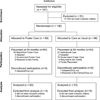Stereotypies in children with a history of early institutional care
- PMID: 20439790
- PMCID: PMC4086785
- DOI: 10.1001/archpediatrics.2010.47
Stereotypies in children with a history of early institutional care
Abstract
Objectives: To investigate the prevalence of stereotypies in children with a history of early institutional care, evaluate the efficacy of a foster care intervention compared with institutional care on the course of stereotypies, and describe correlates in language, cognition, and anxiety for children who exhibit stereotypies.
Design: Randomized controlled trial.
Setting: Institutions in Bucharest, Romania.
Participants: One hundred thirty-six children with a history of early institutional care. Intervention Comparison of a foster care intervention with continued care as usual in an institution.
Main outcome measures: The presence of stereotypies as well as outcomes in language, cognition, and anxiety.
Results: At the baseline assessment prior to placement in foster care (average age of 22 months), more than 60% of children in institutional care exhibited stereotypies. Follow-up assessments at 30 months, 42 months, and 54 months indicated that being placed in families significantly reduced stereotypies, and with earlier and longer placements, reductions became larger. For children in the foster care group, but not in the care as usual group, stereotypies were significantly associated with lower outcomes on measures of language and cognition.
Conclusions: Stereotypies are prevalent in children with a history of institutional care. A foster care intervention appears to have a beneficial/moderating role on reducing stereotypies, underscoring the need for early placement in home-based care for abandoned children. Children who continue to exhibit stereotypies after foster care placement are significantly more impaired on outcomes of language and cognition than children without stereotypies and thus may be a target for further assessments or interventions.
Trial registration: ClinicalTrials.gov NCT00747396.
Figures



Comment in
-
What do Romanian children living in orphanages manifesting repetitive behaviors and American children in foster care with abnormal cortisol levels have in common? More than you would think.Arch Pediatr Adolesc Med. 2010 May;164(5):492-3. doi: 10.1001/archpediatrics.2010.66. Arch Pediatr Adolesc Med. 2010. PMID: 20439804 No abstract available.
Similar articles
-
Institutional rearing and psychiatric disorders in Romanian preschool children.Am J Psychiatry. 2009 Jul;166(7):777-85. doi: 10.1176/appi.ajp.2009.08091438. Epub 2009 Jun 1. Am J Psychiatry. 2009. PMID: 19487394 Clinical Trial.
-
Cognitive recovery in socially deprived young children: the Bucharest Early Intervention Project.Science. 2007 Dec 21;318(5858):1937-40. doi: 10.1126/science.1143921. Science. 2007. PMID: 18096809 Clinical Trial.
-
Motor outcomes in children exposed to early psychosocial deprivation.J Pediatr. 2014 Jan;164(1):123-129.e1. doi: 10.1016/j.jpeds.2013.09.026. Epub 2013 Oct 22. J Pediatr. 2014. PMID: 24161221 Free PMC article. Clinical Trial.
-
Psychiatric outcomes in young children with a history of institutionalization.Harv Rev Psychiatry. 2011 Jan-Feb;19(1):15-24. doi: 10.3109/10673229.2011.549773. Harv Rev Psychiatry. 2011. PMID: 21250893 Free PMC article. Review.
-
A new model of foster care for young children: the Bucharest early intervention project.Child Adolesc Psychiatr Clin N Am. 2009 Jul;18(3):721-34. doi: 10.1016/j.chc.2009.03.003. Child Adolesc Psychiatr Clin N Am. 2009. PMID: 19486847 Review.
Cited by
-
Rethinking Stereotypies in Autism.Semin Pediatr Neurol. 2021 Jul;38:100897. doi: 10.1016/j.spen.2021.100897. Epub 2021 May 31. Semin Pediatr Neurol. 2021. PMID: 34183141 Free PMC article. Review.
-
Emerging roles of epigenetic mechanisms in the enduring effects of early-life stress and experience on learning and memory.Neurobiol Learn Mem. 2011 Jul;96(1):79-88. doi: 10.1016/j.nlm.2011.02.008. Epub 2011 Feb 19. Neurobiol Learn Mem. 2011. PMID: 21338703 Free PMC article. Review.
-
Motor stereotypies and cognitive perseveration in non-human primates exposed to early gestational irradiation.Neuroscience. 2013 Sep 17;248:213-24. doi: 10.1016/j.neuroscience.2013.06.006. Epub 2013 Jun 13. Neuroscience. 2013. PMID: 23769911 Free PMC article.
-
Primate evidence on the late health effects of early-life adversity.Proc Natl Acad Sci U S A. 2012 Jun 5;109(23):8866-71. doi: 10.1073/pnas.1205340109. Epub 2012 May 21. Proc Natl Acad Sci U S A. 2012. PMID: 22615410 Free PMC article.
-
Decreased environmental complexity during development impairs habituation of reinforcer effectiveness of sensory stimuli.Behav Brain Res. 2018 Jan 30;337:53-60. doi: 10.1016/j.bbr.2017.09.032. Epub 2017 Sep 21. Behav Brain Res. 2018. PMID: 28943426 Free PMC article.
References
-
- Mason G. Stereotypies: a critical review. Anim Behav. 1991;41:1015–1037.
-
- Wolf DS, Singer HS. Pediatric movement disorders: an update. Curr Opin Neurol. 2008;21:491–496. - PubMed
-
- Muthugovindan D, Singer H. Motor stereotypy disorders. Curr Opin Neurol. 2009;22:131–136. - PubMed
-
- Garner JP, Meehan CL, Mench JA. Stereotypies in caged parrots, schizophrenia and autism: evidence for a common mechanism. Behav Brain Res. 2003;145:125–134. - PubMed
-
- Lutz C, Well A, Novak M. Stereotypic and self-injurious behavior in rhesus macaques: A survey and retrospective analysis of environment and early experience. Am J Primatol. 2003;60:1–15. - PubMed

